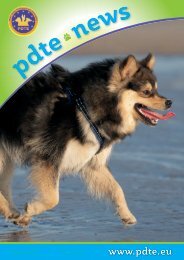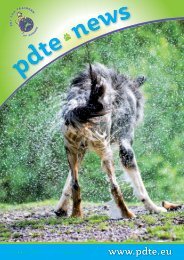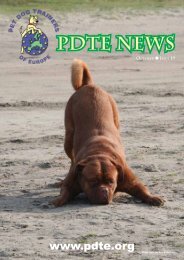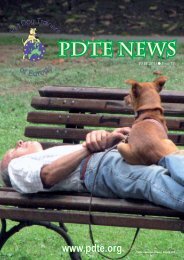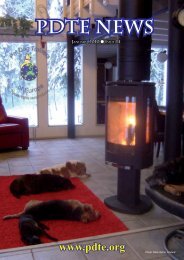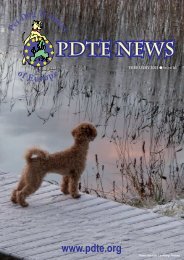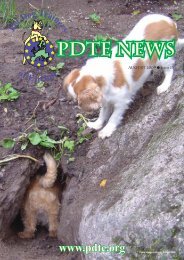PDTE 2013 Winter Newsletter
Create successful ePaper yourself
Turn your PDF publications into a flip-book with our unique Google optimized e-Paper software.
well because the dogs automatically<br />
sit themselves, and it is a good way for<br />
the owners to treat them on time.<br />
KNOWING THE BREED<br />
The Kooiker is a Dutch hunting dog. It<br />
was originally used to lure and drive<br />
ducks into cages known as kooien,<br />
which were basically canals ending in<br />
traps in which the hunter could easily<br />
catch the fowl. The dogs lured the<br />
ducks by wagging their furry white<br />
tails. The breed is independent, which<br />
allows them to work by themselves.<br />
They are alert, which allows them to<br />
act quickly and they are not too noisy,<br />
which is important for luring.<br />
For the search, we chose good equipment<br />
such as a 3 m long leash, a<br />
harness, and of course good treats<br />
and plenty of water. A long leash is<br />
important because, as we all know, trying<br />
to learn something with someone<br />
standing over your shoulder is a bit<br />
uncomfortable. Sniffing also produces<br />
a dry mouth, which is why water is<br />
important. If the dogs are not drinking<br />
enough water, they can be inaccurate<br />
in their work. And of course<br />
breaks are important — for both dog<br />
and owner, especially in this case as<br />
the owners need plenty of breaks for<br />
their bodies. When a break is necessary<br />
is sometimes a bit difficult to tell,<br />
but as I like to tell the owners, when<br />
in doubt, keep out! Why are breaks<br />
important? Because when you want<br />
to learn something, you will remember<br />
it better next time if you allow<br />
the brain to eliminate the toxins that<br />
learning produces. People can concentrate<br />
for about 15 minutes very well;<br />
I’m not sure if this is true of dogs or<br />
if it is shorter. During breaks the brain<br />
can process the information from the<br />
previous session. We have all been in<br />
situations where someone is speaking<br />
and we hear the words, but they don’t<br />
make any sense because we are too<br />
tired. It may be a boring subject or a<br />
boring speaker, but most of the time<br />
it is because we don’t take breaks on<br />
time.<br />
STEP-BY-STEP TRAINING<br />
It’s important to do the training in<br />
little steps. So, every time the dog<br />
was successful, we made the task just<br />
a little bit more difficult. Success is<br />
important to keep the dog motivated.<br />
It’s the same with children; they don’t<br />
have much self-confidence so sometimes<br />
it helps to ask them something<br />
very simple in between other questions.<br />
Especially for children who have<br />
poor self-confidence, it helps them<br />
feel that they know something and it<br />
keeps them motivated. The same is<br />
true of dogs.<br />
As we know, dogs learn by association.<br />
So we have to associate the keys with<br />
something nice — which normally for<br />
dogs means food. We keep one hand<br />
behind the back and hold the key in<br />
the other hand, and as soon as the dog<br />
shows interest in the keys, he is treated<br />
from a flat hand. This is quite easy,<br />
because dogs are curious by nature<br />
and will want to investigate what you<br />
have in your hand. Having the hand<br />
with the treat behind the back ensures<br />
that the dog is more interested in the<br />
keys than in the treat.<br />
Next, we move the dog a little further<br />
away in the direction of the keys, starting<br />
by holding the keys further away<br />
from the body, sometimes changing<br />
hands, which stimulates the dog to<br />
think. Gradually we move the keys<br />
towards the ground. In this case, the<br />
owners were sitting on chairs, as it<br />
was more comfortable for them. In a<br />
funny episode with Ed and Windy this<br />
proved a bit challenging, because with<br />
the keys on the ground Ed was looking<br />
at Windy, and Wendy was looking at<br />
Ed, and they were a bit confused as<br />
to what to do next! Ed was probably<br />
expecting Windy to look for the keys,<br />
whereas Windy was looking to Ed for a<br />
treat. The solution to this is don’t look<br />
at your dog! Sometimes it also helps<br />
to look at the keys on the ground. You<br />
can also throw the keys a little further<br />
away, but we need to be careful with<br />
40









